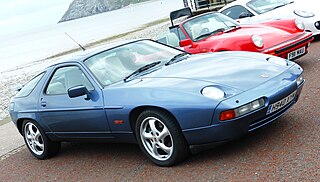
The Porsche 928 is a grand touring car with a 2+2 seating layout manufactured by Porsche AG of Germany from 1978 to 1995. Initially conceived to address changes in the automotive market, it represented Porsche's first fully in-house design for a production vehicle and was intended to potentially replace the Porsche 911 as the company's flagship model. The 928 aimed to blend the performance and handling characteristics of a sports car with the comfort, spaciousness, and ride quality of a luxury car. Porsche executives believed that the 928 would have broader appeal compared to the compact, somewhat outdated, and slow-selling air-cooled 911. Notably, it was Porsche's inaugural production model powered by a V8 engine located at the front, and it achieved remarkable top speeds, earning recognition upon its 1978 release by winning the European Car of the Year award. The Autocar described it as a "super car" in 1980.

The Audi A6 is an executive car manufactured by the German company Audi since 1994. Now in its fifth generation, the successor to the Audi 100 is manufactured in Neckarsulm, Germany, and is available in saloon and estate configurations, the latter marketed by Audi as the Avant. Audi's internal numbering treats the A6 as a continuation of the Audi 100 lineage, with the initial A6 designated as a member of the C4-series, followed by the C5, C6, C7, and the C8. The related Audi A7 is essentially a Sportback (liftback) version of the C7-series and C8-series A6 but is marketed under its own separate identity and model designation.
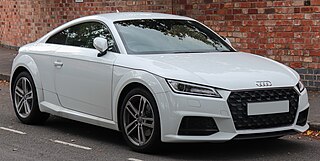
The Audi TT is a production front-engine, 2-door, 2+2 sports coupé and roadster, manufactured and marketed by Audi from 1998 to 2023 across three generations.

The Audi 80 is a compact executive car produced by the Audi subdivision of the Volkswagen Group across four generations from 1966 to 1996. It shared its platform with the Volkswagen Passat from 1973 to 1986 and was available as a saloon, and station wagon — the latter marketed by Audi as the Avant. The coupé and convertible models were not badged as members of the range, but used a derivative of the same platforms.

The Audi A3 is a small family car (C-segment) manufactured and marketed by the German automaker Audi AG since September 1996, currently in its fourth generation.

The Audi A8 is a full-size luxury sedan manufactured and marketed by the German automaker Audi since 1994. Succeeding the Audi V8, and now in its fourth generation, the A8 has been offered with either front- or permanent all-wheel drive and in short- and long-wheelbase variants. The first two generations employed the Volkswagen Group D platform, with the current generation deriving from the MLB platform. After the original model's 1994 release, Audi released the second generation in late 2002, the third in late 2009, and the fourth and current iteration in 2017. Noted as the first mass-market car with an aluminium chassis, all A8 models have used this construction method co-developed with Alcoa and marketed as the Audi Space Frame.

The Audi A5 is a series of compact executive and grand touring coupé cars produced by the German automobile manufacturer Audi since June 2007. The A5 range also includes the coupe, cabriolet, and "Sportback"—a five-door liftback with a fastback roofline—derived from the Audi A4 saloon and estate models.
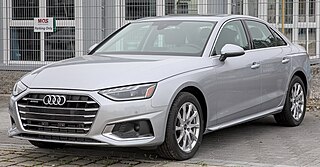
The Audi A4 is a line of luxury compact executive cars produced since 1994 by the German car manufacturer Audi, a subsidiary of the Volkswagen Group. The A4 has been built in five generations and is based on the Volkswagen Group B platform. The first generation A4 succeeded the Audi 80. The automaker's internal numbering treats the A4 as a continuation of the Audi 80 lineage, with the initial A4 designated as the B5-series, followed by the B6, B7, B8, and the B9.
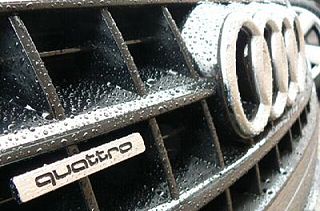
Quattro is the trademark used by the automotive brand Audi to indicate that all-wheel drive (AWD) technologies or systems are used on specific models of its automobiles.

The Audi S4 is the high performance variant of Audi's compact executive car A4. The original Audi S4, built from 1991 until 1994, was a performance-oriented version of Audi's 100 saloon/sedan. All subsequent S4s since 1997 have been based on the Audi A4; and as the A4 has evolved from one generation to the next, so has the S4.
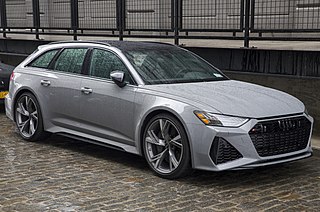
The Audi RS 6 is a high-performance variant of the Audi A6 range, produced by the high-performance subsidiary company Audi Sport GmbH, for its parent company Audi AG, a subsidiary of the Volkswagen Group, from 2002 onwards.
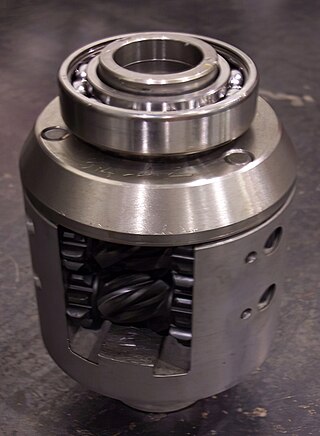
Torsen Torque-Sensing is a type of limited-slip differential used in automobiles.

The Audi RS 4 is the high-performance variant of the Audi A4 range produced by Audi Sport GmbH for AUDI AG, a division of the Volkswagen Group. It sits above the Audi S4 as the fastest, most sports-focused car based on the A4's "B" automobile platform. The RS 4 was reintroduced in 2012, based on the A4 Avant instead of the sedan as did the original model.

The Audi S6 is a high-performance variant of the Audi A6, an executive car produced by German automaker Audi. It went on sale in 1994, shortly after the "A6" designation was introduced, replacing the "100" nameplate.

The Audi S2 is an Audi sports car, manufactured by the division of quattro GmbH on the same platform as the Audi 80 (B4) in Neckarsulm, Germany, produced from 1991 to 1995. The Audi S2 is the first car in the Audi S series. In 1994, a more powerful Audi RS 2 Avant was released.

The Audi A7 is an executive five-door liftback produced by Audi since 2010. The coupé variant of the Audi A6 saloon/estate, the Audi A7 features a sloping roofline with a steeply raked rear window and integrated boot lid, and four frameless doors. A sport version called the S7 has been made since 2012, and a high-performance model called the RS7 has been in production since 2013. An extended-wheelbase three-box, four-door saloon derivative called the A7L has been produced in China since 2021.

The Audi R8 V12 TDI, was a diesel-engined concept car that was first presented to the public at the 2008 North American International Auto Show on 13 January and then the Geneva Motor Show in March in the same year. The car was fitted with a 6.0-litre V12 engine, utilising Volkswagen Group's long-established Turbocharged Direct Injection (TDI) turbodiesel technology. This engine produces 368 kW at 4,000 rpm and 1,000 N⋅m (738 lbf⋅ft) of torque at 1,750-3,000 rpm. The car utilises Audi's quattro permanent four-wheel drive system and a 6-speed manual transmission. The car can accelerate from 0–100 km/h (0–62 mph) in 4.2 seconds, and can reach a top speed of over 300 km/h (186 mph).
5HP is ZF Friedrichshafen AG's trademark name for its 5-speed automatic transmission models for longitudinal engine applications, designed and built by ZF's subsidiary in Saarbrücken.

Volkswagen R is the brand used by the German auto manufacturer Volkswagen to indicate a sport or high performance model. An "R" badge is placed on the grille, front fenders and trunk of R-model vehicles to indicate the vehicle's trim level.

The Volkswagen-Audi V8 engine family is a series of mechanically similar, gasoline-powered and diesel-powered, V-8, internal combustion piston engines, developed and produced by the Volkswagen Group, in partnership with Audi, since 1988. They have been used in various Volkswagen Group models, and by numerous Volkswagen-owned companies. The first spark-ignition gasoline V-8 engine configuration was used in the 1988 Audi V8 model; and the first compression-ignition diesel V8 engine configuration was used in the 1999 Audi A8 3.3 TDI Quattro. The V8 gasoline and diesel engines have been used in most Audi, Volkswagen, Porsche, Bentley, and Lamborghini models ever since. The larger-displacement diesel V8 engine configuration has also been used in various Scania commercial vehicles; such as in trucks, buses, and marine (boat) applications.






















